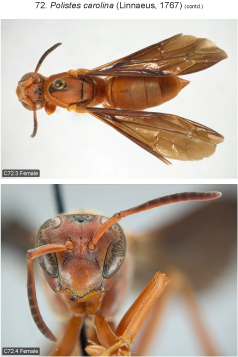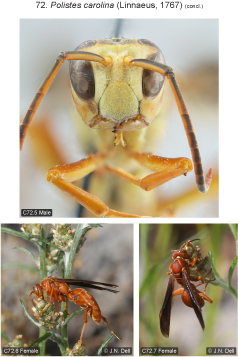
| Home | Table of contents | Keys | Species list | Glossary | Image data | PDF | Cite this article | Feedback | Updates |
Identification Atlas of the Vespidae (Hymenoptera, Aculeata) of the northeastern Nearctic region
CJAI 05, February 19, 2008
doi: 10.3752/cjai.2008.05
Matthias Buck, Stephen A. Marshall, and David K.B. Cheung
Department of Environmental Biology, University of Guelph, Guelph, Ontario, Canada N1G 2W1
Next species | Previous species | Key
72. Polistes carolina (Linnaeus, 1767)
Figs B10.9, 15, 21, 38, 49; C72.1–7.
 |

|
 |
Species recognition. This species and P. perplexus are the only species in the east with almost completely ferruginous body. Females of P. carolina differ from P. perplexus by the largely bare malar space and lower gena, which contrasts with the finely silvery pubescent upper gena (in P. perplexus both malar space and gena are silvery pubescent). Previously, males of both species could not be separated. In material examined by us both sexes of P. perplexus show consistently coarser transverse ridging of the propodeum than P. carolina.
Variation. Fore wing length 15.0–20.5 mm (both sexes). Female. Body almost entirely ferruginous, sometimes with the following black markings: spot(s) around ocelli (typically one minute spot around each ocellus, rarely confluent and forming a single rectangular or irregular mark); distal half of dorsal surface of scape (rarely), medial spot in front of pronotal carina, incomplete central stripe and rarely margins and incomplete lateral stripes on scutum, mesosoma behind fore coxae, some mesosomal sutures, median stripe of propodeum (usually incomplete), and narrow anterior bands on sternum 2 and terga 3 and 4. Flagellum more or less darkened along entire dorsal surface except sometimes parts of flagellomere 1. Yellow markings also very restricted, sometimes present on mandibles, clypeus, inner orbit, propodeal valvula, propodeal stripes (exceptional), tergum 1 (apical fascia), outer surface of tibiae and tarsi. Male differs from female as follows: Black or dark brown markings often better developed, including sometimes small spots on posterior surface of fore and mid femur, and spots on sterna 3–6. Yellow markings very variable: in xanthic specimens including entire face up to upper limit of eye emargination, malar space and lower gena, pronotal carina, lateral surfaces of pronotum, anterior and ventral areas of mesopleuron, indistinct upper mesopleural spot (suffused with ferruginous), small spot on upper metapleuron, anterior surfaces of all coxae, trochanters and femora, sternum 1 more or less yellowish, large yellow basal spot on sternum 2 and partially developed apical fasciae of sterna 3 and 4. Most specimens have the median portion of the face as well as the median part of the dorsal 2/3 of the clypeus somewhat suffused with ferruginous. The most ferruginous specimens lack most of the yellow markings of the mesosoma, metasoma, coxae and femora except small mesopleural spots behind the fore coxae.
Distribution. Canada: recorded for the first time from ON as an adventitious species (not established). Eastern U.S.: NY, PA, OH south to FL, west to IL, KS, AR and eastern TX. Introduced to Bermuda (Richards 1978, Carpenter 1996a).
Biology. Nests in more or less exposed areas such as under roofs of buildings or in old tires. The species has often been reported to nest in protected sites (e.g., hollow trees) but these reports are apparently due to confusion with P. perplexus (Wade and Nelson 1978). Prey consists of caterpillars and Chrysomelidae larvae. One report describes an attack on a cicada (Tibicen auletes Germar) (Richards 1978). Due to confusion with the very similar P. perplexus some of the biological information published might actually refer to that species.
Next species | Previous species | Key
| Home | Table of contents | Keys | Species list | Glossary | Image data | PDF | Cite this article | Feedback | Updates |
